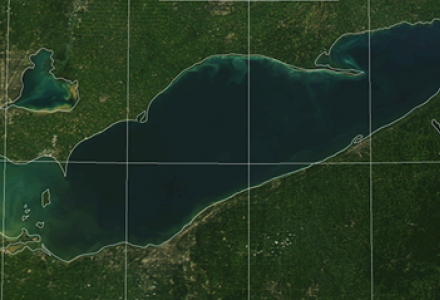
A new Cooperative Institute for Great Lakes Research (CIGLR) was formed by the University of Michigan to infuse social science, engineering, and landscape design into ongoing natural science research across the lakes.

A five-year grant from the US National Oceanic and Atmospheric Administration (NOAA) supports a research institute at the University of Michigan and a binational regional consortium spanning all five lakes. CIGLR research is in partnership with the NOAA Great Lakes Environmental Research Laboratory (GLERL) in Ann Arbor, where CIGLR research institute staff are housed. CIGLR is one of 16 NOAA Cooperative Institutes across the US that link academic institutions with NOAA research laboratories to expand NOAA’s research capabilities.
The Great Lakes are too vast, and the problems too complex, for any one university to tackle alone. The CIGLR regional consortium broadens the intellectual expertise, research capacity, and geographic scope of NOAA's Great Lakes research programs. More than 200 principal investigators at partner universities are sharing their intellectual and research capabilities. That includes 10 field stations, a fleet of 12 research vessels, more than a dozen engineering and design labs, a well-coordinated system of 38 mooring stations, mobile platforms and remote-sensing systems, and specialty labs in genomics, Geographic Information Systems (GIS), high-performance computing, and physical-chemical analyses.
Consortium members include universities, businesses, nongovernmental organizations, NOAA programs, government centers, and national and international commissions, including the International Joint Commission. Primary academic partners are: Central Michigan University, Cornell University, Grand Valley State University, Michigan State University, Ohio State University, University of Michigan, University of Minnesota-Duluth, University of Windsor, and University of Wisconsin-Milwaukee.

The new institute supersedes the Cooperative Institute for Limnology and Ecosystems Research (CILER), a NOAA-funded collaboration between University of Michigan and NOAA GLERL established in 1989. The name change reflects the increasing breadth of the institute's research, which originally focused on natural science but is evolving to interdisciplinary work including social sciences, engineering, and landscape design. CIGLR is focusing more heavily on the co-design of research programs, forging partnerships between research scientists and data users who will work side-by-side to define the original questions and prioritize the products needed to solve problems. By partnering with technology development companies, Great Lakes industries, nongovernmental organizations and organizations like IJC, the new institute will help accelerate the transition of NOAA research into applications for society.

Nearly half of the investigators in the regional consortium are social or engineering and design scientists. CIGLR recently hired two social scientists to work within the research institute, focusing on stakeholder engagement and the human dimensions of Great Lakes water quality problems, such as harmful algal blooms and depleted oxygen, or hypoxia. These social scientists are working alongside physical scientists to involve water treatment managers in the design and implementation of a hypoxia forecast system for Lake Erie that will help predict changes to drinking water quality.
As a complement to CIGLR’s interdisciplinary and collaborative research, the institute’s ECO Program fosters the transfer of Great Lakes research and knowledge into actionable science. ECO Program goals include:
- Engagement - Support informed decision making by advising local, state, and federal policymakers about the importance of Great Lakes’ ecosystem services
- Career training - Promote a diverse, skilled workforce with career training for undergraduates, graduate students, and postdocs who will be the next generation of Great Lakes and NOAA scientists
- Outreach and communications - Advance environmental literacy by communicating the value, importance, and utility of NOAA’s Great Lakes research to the general public.
To learn more, subscribe to the CIGLR newsletter and follow CIGLR on social media: Facebook, Twitter, and Instagram.
Mary Ogdahl is the CIGLR program manager at the University of Michigan in Ann Arbor.




